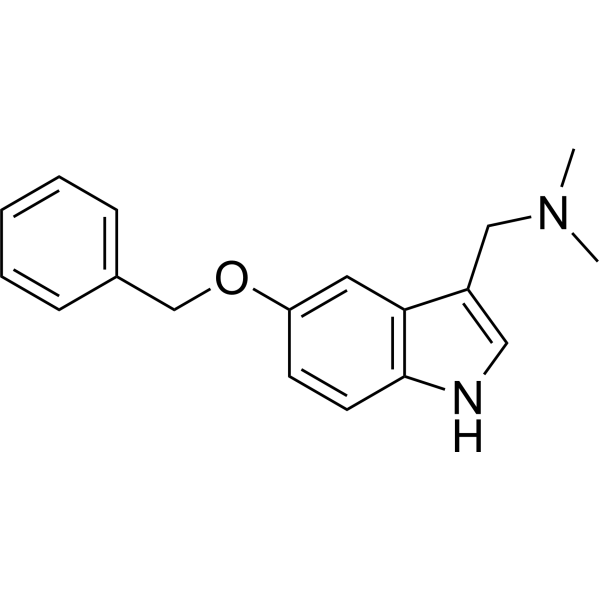Physicochemical Properties
| Molecular Formula | C18H20N2O |
| Molecular Weight | 280.36 |
| Exact Mass | 280.158 |
| CAS # | 1453-97-0 |
| PubChem CID | 73814 |
| Appearance | Off-white to light yellow solid powder |
| Density | 1.153g/cm3 |
| Boiling Point | 442.3ºC at 760mmHg |
| Melting Point | 137-139 °C(lit.) |
| Flash Point | 221.3ºC |
| Vapour Pressure | 5.06E-08mmHg at 25°C |
| LogP | 3.808 |
| Hydrogen Bond Donor Count | 1 |
| Hydrogen Bond Acceptor Count | 2 |
| Rotatable Bond Count | 5 |
| Heavy Atom Count | 21 |
| Complexity | 314 |
| Defined Atom Stereocenter Count | 0 |
| SMILES | C(OC1=CC=C2C(C(CN(C)C)=CN2)=C1)C1C=CC=CC=1 |
| InChi Key | POTVAILTNPOQJH-UHFFFAOYSA-N |
| InChi Code | InChI=1S/C18H20N2O/c1-20(2)12-15-11-19-18-9-8-16(10-17(15)18)21-13-14-6-4-3-5-7-14/h3-11,19H,12-13H2,1-2H3 |
| Chemical Name | N,N-dimethyl-1-(5-phenylmethoxy-1H-indol-3-yl)methanamine |
| HS Tariff Code | 2934.99.9001 |
| Storage |
Powder-20°C 3 years 4°C 2 years In solvent -80°C 6 months -20°C 1 month |
| Shipping Condition | Room temperature (This product is stable at ambient temperature for a few days during ordinary shipping and time spent in Customs) |
Biological Activity
| ln Vitro | 5-benzyloxygramine causes aberrant N protein oligomerization, which has been further validated in the cell, by stabilizing the N-NTD dimers through concurrent hydrophobic contacts with both partners[1]. |
| References | [1]. Shan-Meng Lin, et al. Structure-Based Stabilization of Non-native Protein-Protein Interactions of Coronavirus Nucleocapsid Proteins in Antiviral Drug Design. J Med Chem. 2020 Mar 26;63(6):3131-3141. |
Solubility Data
| Solubility (In Vitro) | DMSO : 250 mg/mL (891.71 mM) |
| Solubility (In Vivo) |
Solubility in Formulation 1: ≥ 2.08 mg/mL (7.42 mM) (saturation unknown) in 10% DMSO + 40% PEG300 + 5% Tween80 + 45% Saline (add these co-solvents sequentially from left to right, and one by one), clear solution. For example, if 1 mL of working solution is to be prepared, you can add 100 μL of 20.8 mg/mL clear DMSO stock solution to 400 μL PEG300 and mix evenly; then add 50 μL Tween-80 to the above solution and mix evenly; then add 450 μL normal saline to adjust the volume to 1 mL. Preparation of saline: Dissolve 0.9 g of sodium chloride in 100 mL ddH₂ O to obtain a clear solution. Solubility in Formulation 2: ≥ 2.08 mg/mL (7.42 mM) (saturation unknown) in 10% DMSO + 90% (20% SBE-β-CD in Saline) (add these co-solvents sequentially from left to right, and one by one), clear solution. For example, if 1 mL of working solution is to be prepared, you can add 100 μL of 20.8 mg/mL clear DMSO stock solution to 900 μL of 20% SBE-β-CD physiological saline solution and mix evenly. Preparation of 20% SBE-β-CD in Saline (4°C,1 week): Dissolve 2 g SBE-β-CD in 10 mL saline to obtain a clear solution. Solubility in Formulation 3: ≥ 2.08 mg/mL (7.42 mM) (saturation unknown) in 10% DMSO + 90% Corn Oil (add these co-solvents sequentially from left to right, and one by one), clear solution. For example, if 1 mL of working solution is to be prepared, you can add 100 μL of 20.8 mg/mL clear DMSO stock solution to 900 μL of corn oil and mix evenly. (Please use freshly prepared in vivo formulations for optimal results.) |
| Preparing Stock Solutions | 1 mg | 5 mg | 10 mg | |
| 1 mM | 3.5668 mL | 17.8342 mL | 35.6684 mL | |
| 5 mM | 0.7134 mL | 3.5668 mL | 7.1337 mL | |
| 10 mM | 0.3567 mL | 1.7834 mL | 3.5668 mL |
